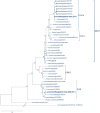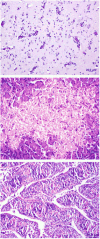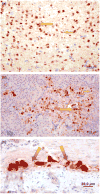Unusually High Mortality in Waterfowl Caused by Highly Pathogenic Avian Influenza A(H5N1) in Bangladesh
- PMID: 25892457
- PMCID: PMC4635058
- DOI: 10.1111/tbed.12354
Unusually High Mortality in Waterfowl Caused by Highly Pathogenic Avian Influenza A(H5N1) in Bangladesh
Abstract
Mortality in ducks and geese caused by highly pathogenic avian influenza A(H5N1) infection had not been previously identified in Bangladesh. In June-July 2011, we investigated mortality in ducks, geese and chickens with suspected H5N1 infection in a north-eastern district of the country to identify the aetiologic agent and extent of the outbreak and identify possible associated human infections. We surveyed households and farms with affected poultry flocks in six villages in Netrokona district and collected cloacal and oropharyngeal swabs from sick birds and tissue samples from dead poultry. We conducted a survey in three of these villages to identify suspected human influenza-like illness cases and collected nasopharyngeal and throat swabs. We tested all swabs by real-time RT-PCR, sequenced cultured viruses, and examined tissue samples by histopathology and immunohistochemistry to detect and characterize influenza virus infection. In the six villages, among the 240 surveyed households and 11 small-scale farms, 61% (1789/2930) of chickens, 47% (4816/10 184) of ducks and 73% (358/493) of geese died within 14 days preceding the investigation. Of 70 sick poultry swabbed, 80% (56/70) had detectable RNA for influenza A/H5, including 89% (49/55) of ducks, 40% (2/5) of geese and 50% (5/10) of chickens. We isolated virus from six of 25 samples; sequence analysis of the hemagglutinin and neuraminidase gene of these six isolates indicated clade 2.3.2.1a of H5N1 virus. Histopathological changes and immunohistochemistry staining of avian influenza viral antigens were recognized in the brain, pancreas and intestines of ducks and chickens. We identified ten human cases showing signs compatible with influenza-like illness; four were positive for influenza A/H3; however, none were positive for influenza A/H5. The recently introduced H5N1 clade 2.3.2.1a virus caused unusually high mortality in ducks and geese. Heightened surveillance in poultry is warranted to guide appropriate diagnostic testing and detect novel influenza strains.
Keywords: Bangladesh; H5N1 subtype; clade 2.3.2.1a; duck; goose; histopathology; immunohistochemistry; influenza A virus; outbreaks.
© 2015 Blackwell Verlag GmbH.
Figures





Similar articles
-
A new reassortant clade 2.3.2.1a H5N1 highly pathogenic avian influenza virus causing recent outbreaks in ducks, geese, chickens and turkeys in Bangladesh.Transbound Emerg Dis. 2019 Sep;66(5):2120-2133. doi: 10.1111/tbed.13264. Epub 2019 Jun 20. Transbound Emerg Dis. 2019. PMID: 31168925
-
Genetic analysis of avian influenza A viruses isolated from domestic waterfowl in live-bird markets of Hanoi, Vietnam, preceding fatal H5N1 human infections in 2004.Arch Virol. 2009;154(8):1249-61. doi: 10.1007/s00705-009-0429-2. Epub 2009 Jul 4. Arch Virol. 2009. PMID: 19578928
-
Avian influenza surveillance reveals presence of low pathogenic avian influenza viruses in poultry during 2009-2011 in the West Bengal State, India.Virol J. 2012 Aug 7;9:151. doi: 10.1186/1743-422X-9-151. Virol J. 2012. PMID: 22867041 Free PMC article.
-
Highly pathogenic avian influenza H5N1, Thailand, 2004.Emerg Infect Dis. 2005 Nov;11(11):1664-72. doi: 10.3201/eid1111.050608. Emerg Infect Dis. 2005. PMID: 16318716 Free PMC article. Review.
-
Origin and evolution of highly pathogenic H5N1 avian influenza in Asia.Vet Rec. 2005 Aug 6;157(6):159-64. doi: 10.1136/vr.157.6.159. Vet Rec. 2005. PMID: 16085721 Review.
Cited by
-
Phylodynamics of high pathogenicity avian influenza virus in Bangladesh identifying domestic ducks as the amplifying host reservoir.Emerg Microbes Infect. 2024 Dec;13(1):2399268. doi: 10.1080/22221751.2024.2399268. Epub 2024 Sep 10. Emerg Microbes Infect. 2024. PMID: 39207215 Free PMC article.
-
Prevalence and risk factors of Avian Influenza Viruses among household ducks in Chattogram, Bangladesh.Vet Res Commun. 2022 Jun;46(2):471-480. doi: 10.1007/s11259-021-09874-4. Epub 2022 Jan 13. Vet Res Commun. 2022. PMID: 35022959
-
Highly Pathogenic Avian Influenza Virus A/H5N1 Infection in Vaccinated Meat Duck Flocks in the Mekong Delta of Vietnam.Transbound Emerg Dis. 2016 Apr;63(2):127-35. doi: 10.1111/tbed.12470. Epub 2016 Jan 8. Transbound Emerg Dis. 2016. PMID: 26748550 Free PMC article.
-
Major zoonotic diseases of public health importance in Bangladesh.Vet Med Sci. 2021 Jul;7(4):1199-1210. doi: 10.1002/vms3.465. Epub 2021 Mar 2. Vet Med Sci. 2021. PMID: 33650812 Free PMC article. Review.
-
Pathogenicity and pathogenesis of a recent highly pathogenic avian influenza subtype H5N8 in mule ducklings in Egypt.Vet World. 2023 Jan;16(1):59-67. doi: 10.14202/vetworld.2023.59-67. Epub 2023 Jan 10. Vet World. 2023. PMID: 36855343 Free PMC article.
References
-
- Alexander DJ. The Second International Symposium on Avian Influenza, 1986. University of Wisconsin; Madison: 1987. Avian influenza — historical aspects; pp. 4–13.
-
- Biswas PK, Christensen JP, Ahmed SSU, Barua H, Das A, Rahman MH, Giasuddin M, Habib MA, Hannan ASMA, Debnath NC. Mortality rate and clinical features of highly pathogenic avian influenza in naturally infected chickens in Bangladesh. Rev Sci Tech. 2011;30:871–878. - PubMed
-
- Brooks WA, Alamgir AS, Sultana R, Islam MS, Rahman M, Fry AM, Shu B, Lindstrom S, Nahar K, Goswami D, Haider MS, Nahar S, Butler E, Hancock K, Donis RO, Davis CT, Zaman RU, Luby SP, Uyeki TM, Rahman M. Avian influenza virus A (H5N1), detected through routine surveillance, in child, Bangladesh. Emerg Infect Dis. 2009;15:1311–1313. - PMC - PubMed
MeSH terms
Associated data
- Actions
- Actions
- Actions
- Actions
- Actions
- Actions
Grants and funding
LinkOut - more resources
Full Text Sources
Other Literature Sources
Medical

